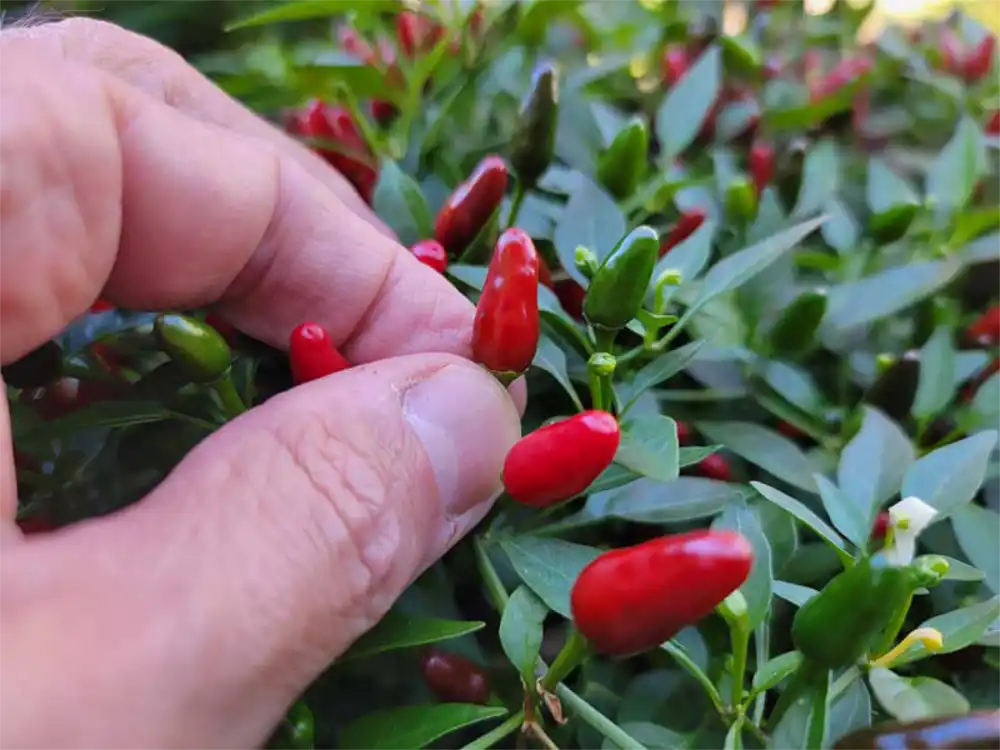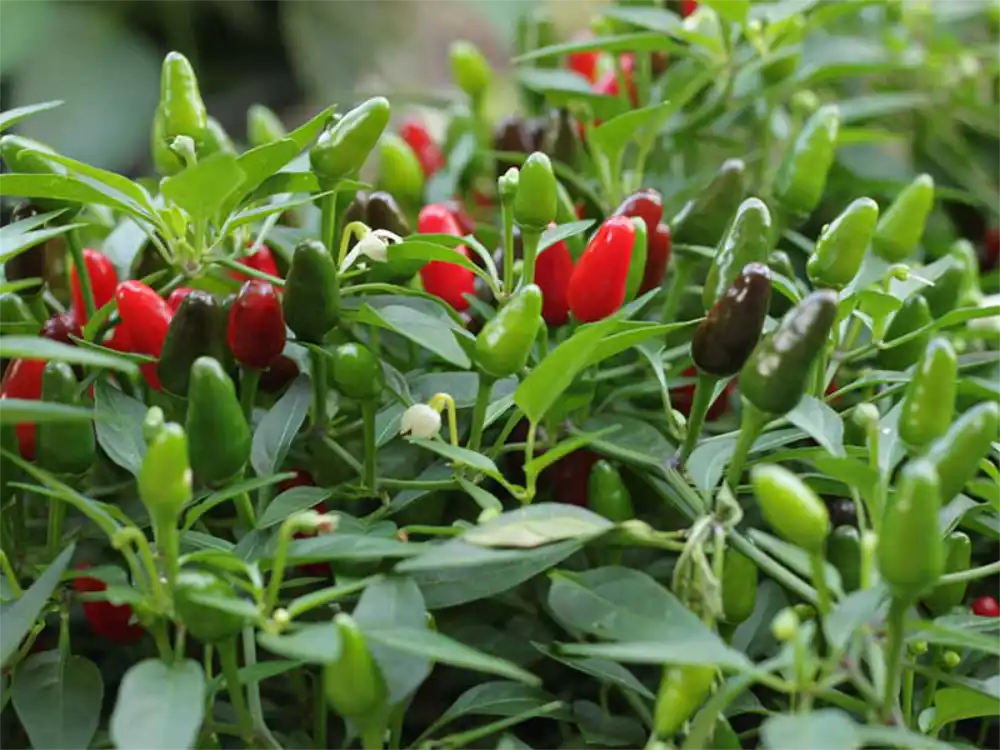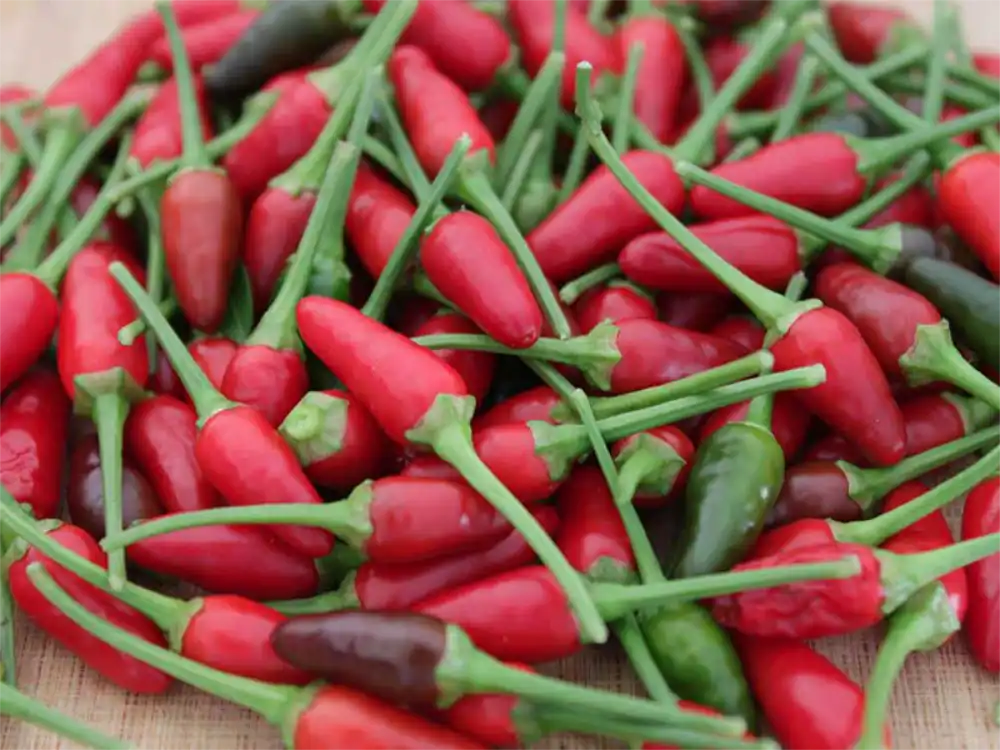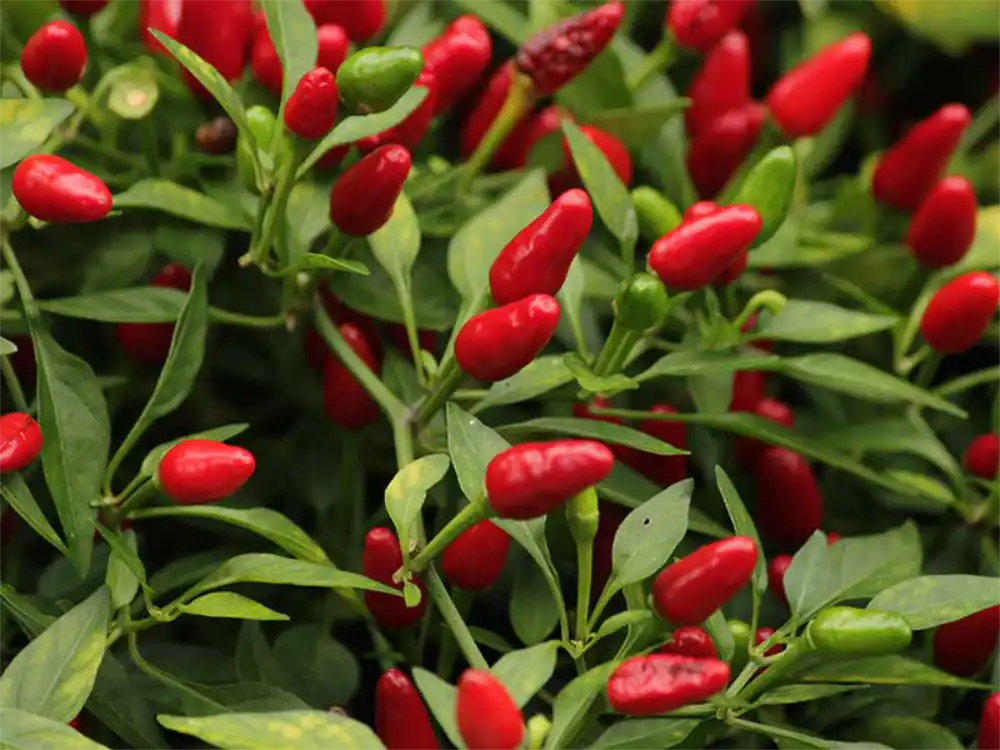Vegetable Gardening
How to Grow Bird’s Eye Peppers: Get Your Spice On
Are you a spice lover looking to add some heat to your garden? Look no further than Bird’s Eye peppers! In this article, we’ll provide you with a step-by-step guide on how to grow bird’s eye peppers, from seed to harvest, so you can spice up your garden and your kitchen!
Why Grow Bird’s Eye Peppers?
Bird’s eye peppers, also known as Peri Peri, Piri Piri, African Devil, and Malawi Bird’s Eye Chili, are a popular choice for spice lovers and culinary enthusiasts alike. These tiny peppers are known for their intense heat, which ranges from 50,000 to 100,000 Scoville Heat Units (SHU).
In addition to their heat, bird’s eye peppers also have a unique flavor profile, with fruity and slightly sweet notes that add depth to dishes. These small, fiery peppers pack a punch and can add a burst of flavor to your culinary creations. My Filipino friends even use the leaves to make Chicken Tinola.
It’s easy to grow Bird’s Eye peppers, making them suitable for both beginner and experienced gardeners. They are also versatile and can be grown in various climates and regions, making them a great addition to any garden. They are an excellent choice for growing in containers since the plants only grow to about 18-24″ tall.
The peppers are tiny, reaching only an inch or so in length. However, the plants are very prolific, producing hundreds of chilis. Bird’s Eye pepper plants grow very bushy with small leaves and fragile branches.
Caution should be taken when harvesting to avoid breaking the stems. Frequent harvesting will encourage the production of more chili peppers.
Basic Info

| Common Name | Bird’s Eye Peppers |
| Scientific Name | Capsicum annuum |
| Days to Harvest | 60-90 days from transplanting |
| Light | Full sun (6-8 hours of direct sunlight) |
| Soil | Well-draining, fertile soil |
| Water | Regular watering, keeping soil evenly moist |
| Fruit Size | Less than 1″ long |
| Mature Plant Height | Up to 24″ |
| Scoville Rating (SHU) | Up to 100,000 |
Starting Seeds Indoors: How to Grow Bird’s Eye Peppers
Starting your Bird’s Eye pepper seeds is a great way to get a head start on the growing season and ensure healthy and vigorous plants. Here’s a step-by-step guide on how to start your seeds indoors:
Gather Supplies
You will need the following supplies to start bird’s eye pepper seeds indoors:
- Bird’s Eye pepper seeds
- Seedling starting trays
- Seed starting mix
- Heat mat and thermostat
- Seed starting grow lights
- Water spray bottle
- Prepare the Seedling Trays: Fill the seedling trays or pots with high quality seed starting mix, which is a lightweight and sterile medium that provides the perfect environment for germinating pepper seeds. Moisten the mix with water. You should only be able to squeeze a few drops of water from the soil if moistened properly.
- Plant the Seeds: Plant the bird’s eye pepper seeds about ¼ inch deep in the trays. If you are planting multiple seeds per cell, you can thin them out later when they have grown a few inches tall and choose the healthiest ones to keep.
- Provide Warmth: Pepper seeds need warmth to germinate. You can place the trays on a heat mat to provide bottom heat, which can help speed up germination. You should also cover the trays with a plastic humidity dome to create a mini greenhouse effect and trap warmth and moisture.
- Proper Lighting: Place the planted trays under seedling grow lights. Once the seeds sprout, they’ll need at least 12-14 hours of artificial light each day for optimal growth.
- Water and Care for Seedlings: Keep the seed starting mix evenly moist, but not waterlogged. Avoid overwatering, as it can cause damping-off, a fungal disease that can kill young seedlings. Water the seedlings from the bottom by placing the cells in a tray of water and letting the mix absorb the moisture. This helps prevent overwatering and promotes healthy root development.
- Harden Off and Transplant Outdoors: Before transplanting your bird’s eye pepper seedlings outdoors, they need to be hardened off, which means gradually acclimating them to outdoor conditions. Start by placing the seedlings outdoors in a sheltered and shaded location for a few hours each day, gradually increasing the exposure to sunlight and wind over the course of a week or two. This helps the seedlings adjust to the outdoor environment and prevents transplant shock. Once the seedlings are hardened off, you can transplant them into your garden bed or containers.

Choosing the Right Location
Choosing the right location is crucial when you grow Birds Eye peppers. These peppers thrive in warm and sunny environments, so select a spot in your garden that receives ample sunlight throughout the day. Aim for at least 6-8 hours of direct sunlight daily to ensure optimal growth and fruit development.
In addition to sunlight, it’s also important to consider the soil quality. Bird’s eye peppers prefer well-draining soil that is rich in organic matter. Amend your soil with compost or well-rotted manure to improve its fertility and structure. Avoid heavy or clay soils, as they can cause waterlogging and root rot, which are detrimental to pepper plants.
Transplanting Bird’s Eye Pepper Seedlings
After the last frost has passed and the seedlings have grown to a size of about 6-8 inches tall with a minimum of two sets of true leaves, they are ready for transplanting. Choose a cloudy or overcast day to reduce stress on the seedlings and prevent sunburn.
Prepare the planting holes in your garden bed by digging small holes that are slightly larger than the root ball of the seedlings. Space the holes about 18-24 inches apart, as bird’s eye peppers require adequate spacing for proper growth and air circulation.
Gently remove the seedlings from their pots or trays, being careful not to damage the roots, and place them in the planting holes. Backfill the holes with soil and gently firm the soil around the base of the plants.
Water the transplanted seedlings thoroughly to help them establish in their new location. Keep the soil consistently moist, but not waterlogged, during the initial few weeks to help the plants establish their root systems.
Once the plants are established, you can reduce the frequency of watering, allowing the top inch of soil to dry out between waterings.
Caring for Mature Bird’s Eye Pepper Plants

As your bird’s eye pepper plants mature, they will require ongoing care to ensure healthy growth and a bountiful harvest. Here are some tips to keep in mind:
Fertilization: Bird’s eye peppers are heavy feeders and require regular fertilization throughout the growing season. You can use a balanced, water-soluble fertilizer or a slow-release granular fertilizer with a higher phosphorus content to promote flowering and fruiting.
Follow the package instructions for application rates and frequency, and avoid over-fertilization, as it can lead to excessive foliage growth with reduced fruiting.
Mulching: Applying a layer of organic mulch, such as straw or wood chips, around the base of the plants can help conserve moisture, suppress weeds, and regulate soil temperature. Mulching also adds organic matter to the soil as it breaks down, improving its fertility and structure. Keep the mulch a few inches away from the stem of the plants to prevent rot.
Pruning: Pruning is not necessary when you grow Bird’s Eye peppers, but it can help improve airflow, reduce the risk of diseases, and promote bushier growth. Avoid excessive pruning, as it can reduce fruiting.
Pollination: Bird’s eye peppers are self-pollinating plants, but they can also benefit from pollinators, such as bees and butterflies, to increase fruit set. You can attract pollinators to your garden by planting flowers that provide nectar and pollen, such as marigolds, zinnias, and bee balm, near your bird’s eye pepper plants.
Avoid using pesticides that can harm pollinators, and create a pollinator-friendly environment in your garden.
Harvesting Bird’s Eye Peppers
Bird’s eye peppers are ready for harvest when they reach their mature color. The peppers can be harvested at any stage of maturity, green or red, depending on your preference for heat and flavor.
To harvest the peppers, use a sharp pair of scissors or pruning shears to cut the peppers from the plant, leaving a short stem attached. Avoid pulling or twisting the peppers, as it can damage the plant. Store the harvested peppers in a cool, dry place, or freeze them for longer storage.

Be sure and check out detailed guide about when to harvest Bird’s Eye peppers!
Common Problems: Grow Bird’s Eye Peppers
Like any other plant, bird’s eye peppers may encounter some common problems that can affect their growth and productivity. Here are some issues you may encounter and their solutions:
Blossom Drop: Bird’s eye pepper plants may experience blossom drop, where the flowers fall off without setting fruit. This can be caused by temperature extremes, lack of pollination, or stress. To prevent blossom drop, ensure consistent temperature and humidity levels, attract pollinators to your garden, and provide optimal growing conditions for your plants.
| Pests or Disease | Symptoms | Treatment |
|---|---|---|
| Aphids | Tiny insects on leaves, stems, and buds; curling or yellowing leaves | Spray with insecticidal soap or neem oil |
| Whiteflies | Tiny white insects on undersides of leaves; sticky residue on leaves | Use yellow sticky traps or spray with insecticidal soap or neem oil |
| Thrips | Tiny insects on leaves and flowers; silvery streaks on leaves | Use yellow sticky traps or spray with insecticidal soap or neem oil |
| Spider mites | Tiny pests that cause yellow stippling on leaves; fine webbing on leaves | Spray with insecticidal soap or neem oil; increase humidity around plants |
| Fungal diseases (e.g. powdery mildew, leaf spot) | White powdery coating or spots on leaves; yellowing or wilting leaves | Remove affected leaves; spray with fungicide |
| Bacterial diseases (e.g. bacterial wilt) | Wilting leaves; yellowing or browning of leaves | Remove affected plants; practice good sanitation and avoid overwatering |
| Viral diseases (e.g. mosaic virus) | Mottled or distorted leaves; stunted growth | Remove affected plants; practice good sanitation and control insect vectors |
Conclusion
Learning how to grow Bird’s Eye peppers can be a rewarding and enjoyable experience. With proper care and attention, you can cultivate healthy plants that produce abundant, flavorful peppers.
Remember to provide optimal growing conditions, transplant seedlings carefully, and provide ongoing care, including fertilization, mulching, pruning, and pest control.
Don’t be discouraged by common problems that may arise, as there are solutions available. Share your experiences and tips with fellow gardeners in the comment section below and let’s grow some delicious bird’s eye peppers together! Happy gardening!
FAQ: How to Grow Bird’s Eye Peppers
Are Bird’s Eye peppers hotter than jalapenos?
Bird’s Eye peppers are generally hotter than jalapenos. On the Scoville scale, which measures the heat of peppers, Bird’s Eye peppers range from 50,000 to 100,000 Scoville Heat Units (SHU), while jalapenos typically range from 2,500 to 8,000 SHU.
Which is hotter, red or green Bird’s Eye chili?
Bird’s Eye peppers change color as they mature, with green being the unripe stage and red being the ripe stage. Red Bird’s Eye peppers are typically hotter than green ones, as the heat of the pepper tends to increase as it ripens.
Does picking peppers make more grow?
Yes, picking peppers regularly can actually stimulate more growth. When you pick the peppers, it signals the plant to produce more flowers and fruits in an effort to reproduce. So, harvesting your Bird’s Eye peppers regularly can result in a more abundant harvest.
How do you dry Bird’s Eye peppers?
To dry Bird’s Eye peppers, you can start by harvesting the mature peppers with a pair of scissors or pruning shears. Leave a short stem attached to each pepper for easy handling. Next, you can air dry them by hanging them in a well-ventilated area with good airflow, or you can place them on a wire rack in a warm, dry place. It may take several weeks for the peppers to fully dry, and you can test their readiness by checking for a leathery texture. Once dried, store them in an airtight container for future use.
Can you grow Bird’s Eye peppers indoors all year round?
Yes, it is possible to grow Bird’s Eye peppers indoors all year round with the right conditions. Indoor gardening allows you to create a controlled environment, providing the necessary light, temperature, and humidity for chili pepper plants to thrive. Using grow lights, maintaining consistent temperature and humidity levels, and providing proper ventilation can help you successfully grow chili peppers indoors throughout the year.






